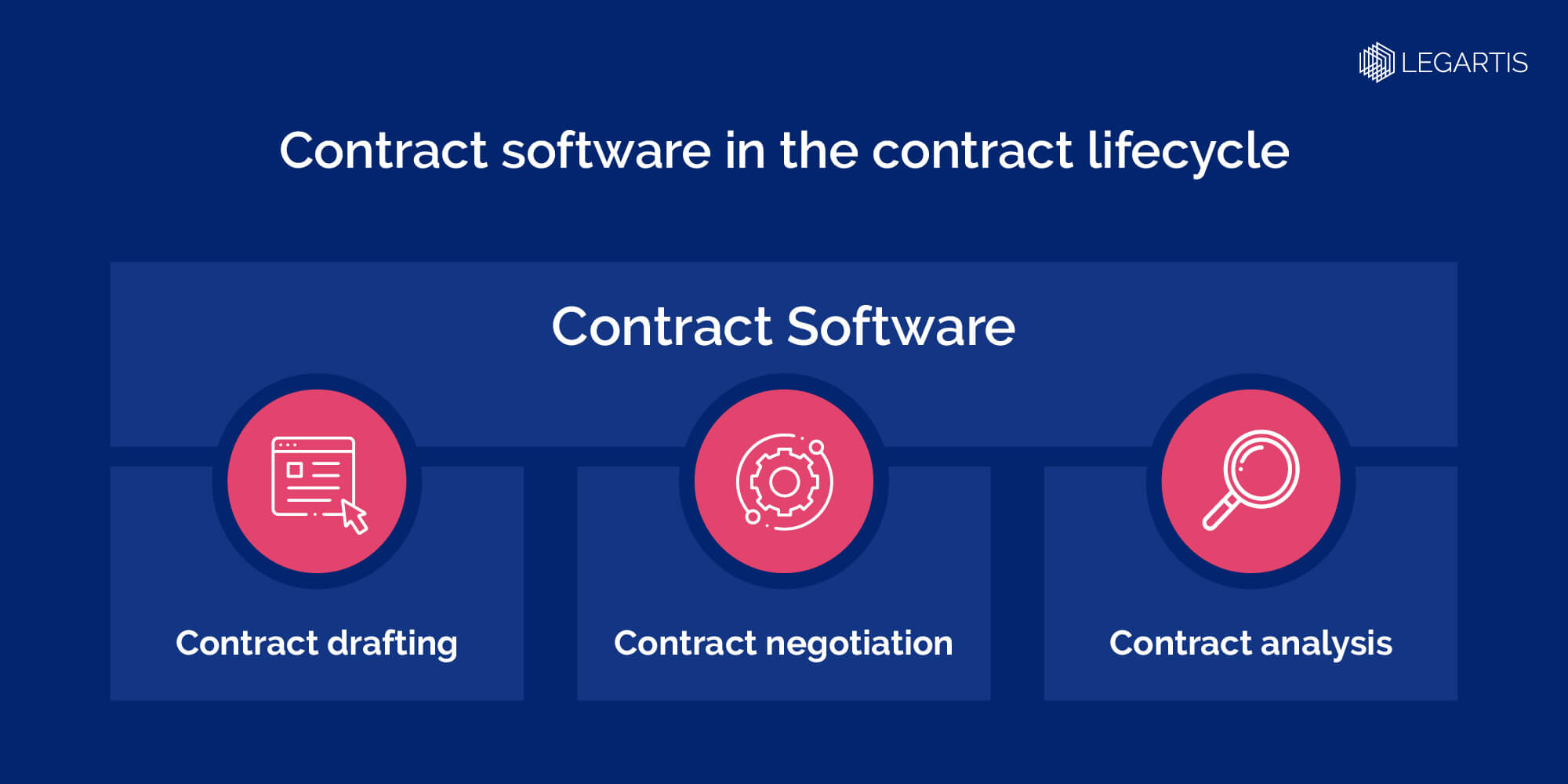A lot of work is involved in the contract lifecycle. Contracts need to be created and negotiated, filed and monitored. Those who still rely on old-school email ping-pong or even filing cabinets instead of contract software for their contract management will soon find themselves at a loss. A high level of effort, susceptibility to errors and a suboptimal i.e. old-fashioned external image are only some of the disadvantages of manual contract organisation.
What companies need today is comprehensive software for contract management – contract software. Using this you can cover the entire contract lifecycle and manage it digitally. This article will:
- introduce you to the topic of contract software,
- help you to define your requirements in order to select the right offer on the market and
- show you different areas of application for contract software.
What is contract software?
Contract software is a collective term for applications that offer digital processes for corporate management of contracts. Contract software often covers all areas of the contract lifecycle, from creation to the post-signing phase. However, the scope of contract software can vary depending on the provider. An important characteristic of contract software is its ability to automate the contract processes that, when done manually, are incredibly tedious.
Accelerate your contract work with an advanced Legal AI!
Advantages of contract software
- Efficiency gains: comprehensive automation leads to your contract management being highly effective. You can achieve excellent results with little effort.
- Cost savings: more efficient processes within administration and coordination require fewer resources – both financial and human.
- Acceleration of contract processes: sales teams can present a draft contract more quickly, communication runs more smoothly and contract controlling becomes faster.
- Management of legal risks: it’s easier for all stakeholders to adhere to and control key legal and compliance requirements.
- Positive contract experience: contracts are the core of every business relationship. When using contract software, you can leave a modern, confident impression on your contractual partner.
The right contract software for your business
The market for contract software may not be huge, but it is big enough to lose track of. So how do you go about finding the right contract software for your business? We recommend that first, you define your needs.
- Pinpoint your requirements: what is particularly important in your area of business? These could be things such as coordinating a large number of signatures or covering the widest possible range of documents. Or maybe the focus is on ready-to-use contract templates for sales.
- Identify your weaknesses: take a closer look at your current contract management system and the lifecycle of your most frequent contract types. Where do things regularly go wrong? In which stages of the contract lifecycle or in which departments do problems and inefficiencies frequently occur?
- Define your goals and expectations: what do you primarily want to achieve with the contract software? How will any future cooperation work? Gather the thoughts of all stakeholders, such as lawyers and business users.
Discover our Legal Tech Map – an overview of the most important legal tech companies in the area of contract management.
These are the phases of the contract lifecycle to use contract software for

With contract software, you have the choice between comprehensive solutions and specialists.
The former guides contracts through the entire contract process. The advantage here is obvious: you have access to a software for extensive contract management without media discontinuity, from a single source.
Specialists in the field of contract software on the other hand concentrate their offer on a defined area of the contract lifecycle, where you use a different type of contract software for each task. With this model, you can cover very specific requirements and also often opt for a best-in-class solution in this respective area.
Below we present three relevant areas of digital contract management solutions in more detail.
Contract drafting
The final signatures on a finished contract are usually preceded by a number of discussions. The contract lifecycle begins in the pre-contractual phase with the first meeting, in which the contracting partners exchange views on what the requirements for the cooperation are.
Based on this, a first draft of the contract is prepared. Normally, one party provides this more or less rough framework as a basis for subsequent contract negotiations.
Typical pain points during the contract drafting process:
- For the preparation of draft contracts, time-consuming manual research must be carried out using the pool of previous documents.
- There is uncertainty about the clauses and exact wording to be used.
- Careless mistakes can creep in that are difficult to identify later.
Contract drafting with contract software
Contract software makes researching during the contract creation almost obsolete. The contract software automatically searches through existing contracts in detail and displays any relevant passages. This means that instead of working out a draft contract from scratch with tedious individual work, lawyers can simply make use of templates or already-reviewed text modules. This also minimises the risk of human error.
Contract software can further be used when receiving a draft contract from your contractual partner. Within a few minutes, the contract software can review the draft – many times faster than even the most experienced lawyers. The contract software compares the draft with the guidelines of the contract playbook; then the legal tech AI filters out inadmissible clauses and draws attention to missing mandatory clauses. This speeds up the contract review, because lawyers can now focus on specific highlighted passages instead of going through the entire document sentence by sentence.
Contract negotiation
Once the basic contract framework is in place, both parties enter into the contract negotiations. In this stage, critical details of the contract terms are discussed and agreements are definitively fixed in writing. The contracting parties review and negotiate the draft contract until they reach a final binding agreement. At this point, the pre-contractual phase turns into contract implementation.
Typical pain points during the contract negotiation process:
- Chaos when passing on different versions of the contract. Which one is the latest version, which one is out of date?
- Media discontinuities in the negotiation process: contracts are written as a Word document, sent as a PDF, printed out by the contractual partner and sent back by post with comments, where the contract is scanned in again ...
- Compliance violations in the contract’s contents that are not initially noticed during the dedicated negotiation phase.
Contract negotiation with contract software
Contract software optimises and automates all the processes involved in contract negotiation. This way, companies can structure their contract negotiation process more effectively. Contract software also supports the coordination of contractual partners, as it allows them to better control and track different versions of the contract or even work collaboratively on them in real time.
Contract software also takes care of the final review of the contract, saving enormous amounts of time, by warning of tricky clauses and suggesting alternative standard clauses. In this way, the software ensures compliance with company guidelines and avoids any legal risks. An automated contract review is also infinitely scalable.
Post-signing: contract analysis
If the contract negotiation was successful, the contract will be stored for future reference – during the contract period in an easily accessible form, then later for archiving in a document management system. The analysis of active as well as inactive contracts is extremely helpful for future contracts and is an important part of the post-contractual phase.
Typical pain points during the contract analysis process:
- Lack of overview: there are simply too many contracts to keep an overview over, stored in different forms in different places.
- Manual analyses consume time units that are urgently needed in day-to-day business.
- Sensitive documents are rarely both genuinely securely stored and accessible for analyses at the same time.
Contract analysis with contract software
Contract software supports the post-contractual phase of the contract lifecycle by lending a hand when a large number of contracts need to be analysed. AI-driven contract software excels at extracting automatically-specified content from contracts; and moreover, you’re not limited to keywords when searching.
Contracts are optimally sorted and securely stored in the document memory. You can quickly find everything you need to carry out compliance checks or legal research.
Key Takeaway
Contract software is an asset to any legal team, helping you to avoid bottlenecks and friction along the entire contract lifecycle. Contract software replaces manual, time-consuming work with often AI-supported digital workflows. In other words: contract processes become automated, standardised and controllable.
Recommended Articles
Agentic Legal AI: When AI Shifts from Assistant to Actor
The days when AI in the legal industry was little more than a glorified spell checker are over. What sounded like science fiction just a few years ago is now reality: Agentic..
Agentic AI: Automated Generated Contract Playbooks
Every day, countless agreements are drafted, negotiated, and signed. For legal departments, legal-ops teams, and procurement leads, it is essential to keep track: Which..
Trends 2025: AI in Contract Analysis
The latest trends in Large Language Models (LLMs) show a shift towards greater efficiency, advanced AI agents and wider adoption across all industries. AI models are becoming..



